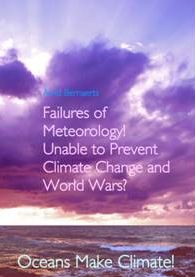|
|
|
Book - The Naval War Effect - details and INDEX below post of 25.
February 2015
Remark: Five out of 19+ images
are shown..
Offshore Wind-parks
and mild Winters. The effect of stirring The
actual winter 2014/15 is up to now no winter in Northern Europa (Fig. 1-2). Can anthropogene activities
in the North Sea, Baltic and coastal seas be made partly responsible? Presumably
yes! Stirring hot coffee will cool it down. At the end of August the sea areas
have gained their maximum potential of warmth. Many ship propellers are plowing
through the sea stirring the surface layer to a depth of 15 meters. In the North
Sea and Baltic there are continuously ten thousand and more motor ships at sea.
Several thousand offshore facilities on the bottom of the sea or anchored offshore
rigs divert currents at sea and influence tides and currents as a permanent resistance
against the normal flow of huge amounts of ocean water. (Fig. 3-8) The result is like stirring hot soup. Warm water will
come to the surface and the heat will supply the atmosphere with warmth. The
air will become warmer and the winters will be milder. The correlation is not
to be overseen. It is not relevant t Strong warming during winter season. The situation at the beginning of the evaluation is obvious.
In Europe the mean average temperature during the last century has risen by 0.9°C.
In the last 30 years the tendency of warming per decade with about 0.41°C was
significantly higher than the global mean of +0.17°C. Warming in central and
northern Europe was very strong and winter temperatures rose faster than summer
temperatures (Ref.). The same is reported about the Baltic. It warmed by
around 0.03°C per decade stronger than other sea areas. In the course of the 20th
century the Baltic warmed by approximately 0.85°C (Ref.). This had a direct influence on air temperatures, as DER SPIEGEL reported several years ago: „….the temperature in the
Baltic area increased by one tenth of a degree, more than the global average ….
The warming of the air in the northern Baltic area by 1°C was higher than in
the southern region with 0.7°C.“.
An example for the importance of the available water
volume is shown in the Baltic. The
increase of mean water temperature near Gotland since 1993 was almost 6°C and around
Bornholm it was about 8°C (Ref.). The mean water depth of the Baltic is 52m (Nord Sea 94m) and is less in
the south than in the eastern Baltic. The explanation of this significant
difference of 2°C can be a different amount of ship traffic. According to HELCOM a permanent number of 2000 large (sizable) ships sail
the Baltic at any time. This implies that this armada agitates the surface
layer down to 10m depth and deeper in the entire Baltic within two weeks. In the
southern Baltic more because of higher ships traffic thus explaining the
greater rise in temperature. That this aspect plays an important role can be
explained by the fact that comparable values in both regions, Gotland and
Bornholm, were only around 4°C.
Small and large weather situation on February 22,
2015, influence in the Chicago area? Europe
is not the world. However Western Europe is under the influence of the weather
belt from West to East. Atlantic low pressure areas move east (Fig.17), unless
cold con Summary: The
facts are conclusive. “Global Climate Change” cannot cause a special rise in
temperatures in Northern Europe, neither in the North Sea nor the Baltic or
beyond. Any use of the oceans by mankind has an influence on thermo-haline
structures within the water column from a few cm to 10m and more. Noticeable
warmer winters in Europe are the logical consequence.
|
|
Published Books: “Climate
Change & Naval War, A Scientific Assessment”, 2005, www.trafford.com Bernaerts’
Guide to 1982 UNCLOS, 2006, www.trafford.com |
THE BOOK WHAT ASTA AND TONY MAY
HAVE THOUGHT IN SUMMER OF 1939
D. CLIMATIC IMPACTS OF WORLD WAR
I
E. GLOBAL COOLING SINCE WWII
F. TIME TO MAKE 20TH CENTURY
CLIMATE CHANGE EXPLAINED |
OVERVIEW
Atlantic SST, 1998 Pacific SST, 1997 PACON, 1997 Peace to Ocean, 1996 Peace to Ocean, 1994 Nature, Letter, 1992 |
||||||
|
Internet links:
1982 UN
Convention Law of the Sea Material in German |
||||||||
|
|
||||||||
|
The thematic in a new publication
Failures of Meteorology! |
|
|
Wohnung zu vermieten
in Spitzenlage.






